Distribution of Certain Mouse and Rat Control Products Ends
On April 1, 2015, Reckitt Benckiser ceased all distribution of 12 d-CON products that do not meet EPA’s current safety standards. EPA reached an agreement with Reckitt, the manufacturer, to cancel these products because they are sold without a protective bait station and pose risks to children and pets. Additionally, eight of the 12 products pose unacceptable risks to certain wildlife. Retailers may sell and consumers may buy these products according to the label until stocks are exhausted. Users of these d-CON products must read and follow the product label instructions.
Household rodenticide products that comply with the Agency’s safety criteria are widely available and are required to be sold and used with a bait station in most use scenarios. EPA encourages consumers to use rodenticide products with bait stations, as proper use of a bait station reduces the risk of accidental exposure to children, pets, and non-target wildlife.
To continue reading click this link: http://www2.epa.gov/rodenticides/canceling-some-d-con-mouse-and-rat-control-products
From Cockroaches to Parasitic Wasps, Creepy Crawlers are for Kids
By Kathleen Phillips, Texas A&M AgriLife Extension Service
A child calmly whispers all his life’s problems to the one who will listen. And in that moment, everything seems so much better.
Perhaps the listener understands. Some days it seems like a crushing blow is around every corner. After all, the one hearing this child’s woes is a bug.
“I’ve seen very disturbed children or autistic kids who could not sit still or focus, sit quietly telling an insect all their problems,” said Dr. Andrine Shufran, Insect Adventure coordinator at Oklahoma State University in Stillwater. “The magic of cockroaches.”
Introducing what others would call “creepy crawlers” to kids is one way entomologists – people who study insects – have witnessed transforming growth both personally and academically for the children they teach.
Shufran is part of the Southwestern Branch-Entomological Society of America Youth Science Committee. Their goal is to help kids get interested in science through bugs.
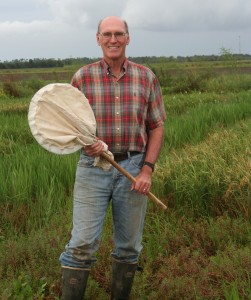
Dr. Mo Way, Texas A&M AgriLife Extension Service entomologist in Beaumont, chairs the Southwestern Branch-Entomological Society of America Youth Science Committee. (Texas A&M AgriLife Extension Service photo)
“Insects provide a lot of hands-on activities to spur kids’ imaginations,” said Dr. Mo Way of Beaumont, Texas A&M AgriLife Extension Service entomologist and committee chair. “Last year, our members in Texas, New Mexico, Oklahoma and Mexico conducted more than 1,000 youth events that reached about 40,000 kids from kindergarten to 12th grade.”
Camps, fairs, competitions, exhibits, classroom talks and even insect birthday parties have enlightened children across the region about “the most widespread and diverse group of organisms on earth: insects,” according to the committee members.
“I find that you can’t go wrong with kids and bugs,” said Molly Keck, AgriLife Extension entomologist in San Antonio. “It’s an easy way to get youth interested in science, the environment and being outdoors.”
One of the main events of the Youth Science Committee is Insect Expo, an annual activity-oriented learning experience for fifth graders, Way noted. There, hundreds of children learn how insects have adapted successfully over time, that the vast majority of insects are beneficial and how each insect has its niche in the ecosystem.
But comments from the kids themselves speak volumes for the lowly insects.
For Seth Fothergill of Friona, it was a praying mantis that got his attention.
“I’ve been interested in insects since the fourth or fifth grade,” said high schooler Fothergill, after a recent FFA entomology contest at West Texas A&M University in Canyon. “It’s interesting how each one is different. But my favorite is the praying mantis. I’ve always thought it was amazing to see how their forelegs work.”
Fothergill said he plans to continue his study of insects through high school and ultimately work in forestry where his knowledge of insects – both harmful and beneficial – will help.
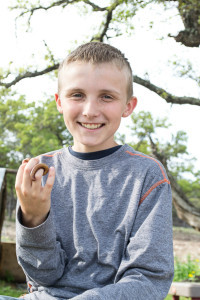
Ian Kosch of San Antonio, holding a golden desert millipede, has parlayed his interest in bugs into having camps and presentations for other children. (Photo courtesy of Ian Kusch)
Kusch became intrigued with insects after attending a bug camp conducted by Keck. He began assisting her class and then decided to set up his own business, The Bug Adventure, to do presentations and host a camp of his own. He’s thinking about entomology for a career, “and basically just keep on doing what I’m doing now,” but also helping people learn how to live with them or get rid of the pests.
He also has some research in mind, based on having learned scientific tidbits such as how roaches can survive radiation, that the desert hairy scorpion can live for years with little water and that a tarantula’s lifespan may be decades.
Bugs were never considered as a way to encourage reluctant reader 8-year-old Crystal Ragains of Adair, Oklahoma, to pick up a book, but that is what happened on a field trip to the entomology lab at Oklahoma State.
Not only were the bugs fascinating, but in meeting the female scientist Shufran, Ragains realized that a world of opportunity awaited her as well. Shufran, not knowing of Ragains’ reluctance to read, told the young girl that reading was a must for having a career in science.
“I started reading about bugs, and now I read about everything,” said Ragains, now 16 and a fan of parasitic wasps and walking sticks.
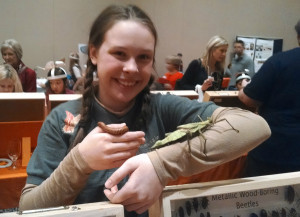
Crystal Ragains of Adair, Oklahoma, got interested in reading through her fascination with insects and now enjoys encouraging other girls to “think outside the box” in exploring the world. (Photo courtesy of Dianna Ragains)
She said delving into insects has allowed her to encourage other girls to explore “outside the box,” in learning about the world.
“Girls and bugs? Girls don’t normally like bugs, but me doing insects may inspire them to do other things that are different,” said Ragains, who often does presentations for other youths.
Dr. Jane Pierce, New Mexico State University Extension entomologist in Artesia, New Mexico, admits to never having outgrown her childhood passion for insects.
“Who doesn’t love bugs when they are 7 years old? We often lose that in junior high, but I have never met a young child who didn’t think bugs were cool,” she said. “Even if they say ‘Ewwww gross!,’ they are smiling while they say it.”
Pierce believes bugs are a fun way to learn about the scientific method, which she said all people should know because it’s “a process that can be a bit messy, but over time the truth becomes clear.”
Dr. Bonnie Pendleton of Canyon, West Texas A&M University entomologist, agrees.
“I think the general public often forgets the tremendous impact, both good and bad, that insects have on humans,” she said. “Insect pests compete with people for food and other valuable resources and cause diseases to humans and livestock. But human society could not exist without the tremendous benefits provided by insects that pollinate plants, decompose wastes and fascinate young people and many of us older ones as well. These kinds of youth activities help students learn about insects and their tremendous impact on all of us.”
Though Way has spent his career battling insect pests, such as the ever-elusive rice water weevil, the use of insects to get children excited about science makes it all beneficial.
“It’s rewarding when you see their smiles and you know you’ve made an impression on that child going in the right direction,” he said.
Termite Season By Molly Keck
Termites are probably the most feared insect to humans … especially homeowners. They portray a vision of a house falling down, circus tent fumigations, a torn up yard, and major expense. Your home is usually your greatest investment; so naturally, a teeny insect that hides underground and eats wood inside your home is a scary thing!
February and March are considered termite swarming season in Texas. Although the weather has been up and down and it’s hard to predict when they may actually swarm, we have gone a few years without a good swarming season, and I imagine if not this year, at least next, will have some good swarms.
A termite swarm is when there is usually extreme humidity (often associated with rain) and the winged termites emerge from the nest to mate and start a new nest. The females will become queens and start a new colony.
Termites are still active at all times of the year, not just during swarming season. In fact, with the extra moisture and warmer weather, they are probably doing just great. Cellulose material from stumps, buried logs, lumber, landscaping timber and firewood are all examples of food sources for termites that most of us have somewhere in the landscape. The closer that is to your house, the more likely they are to start feeding on cellulose in the house.
The good news is that finding termites or termite damage should be mean that you need to take immediate action. Take some time to get some BIDs and figure out the best management options for your situation. You will know if the house is in danger of collapse!
For much more information about termites and management options, a fantastic webinar was provided by Dr. Robert Puckett, an urban entomologist with Texas A&M AgriLife Extension on April 3rd, 2015. He has extensive experience in termite field and lab research.
Follow the link to watch the webinar: https://learn.extension.org/events/1853#.VRQza8Zx0ag
Termites
By Wizzie Brown
There are three main types of termites that can cause problems for homeowners in Central Texas- native subterranean termites, formosan subterranean termites and drywood termites. To identify termites you will need to obtain soldiers (ones with a hard head with large mandibles) or reproductives with wings.
Native subterranean termites have nests in the soil and must maintain contact with soil or an above-ground moisture source to survive. If native subterranean termites move to areas above ground they make shelter (mud) tubes of fecal material, saliva and soil to protect themselves.
Formosan termites are a more voracious type of subterranean termite. These termites have been spread throughout Texas through transport of infested material or soil. Formosan termites build carton nests that allow them to survive above ground without contact with the soil. Nests are often located in hollow spaces, such as wall voids.
Formosan termites feed on a wider variety of cellulose than other subterranean termites, including live plants, consuming both spring and summer growth wood whereas native subterranean termites feed only on spring growth. Formosan termites have also been known to chew through non-cellulose materials such as soft metals, plaster or plastic.
Drywood termites do not need contact with soil and reside in sound, dry wood. These termites obtain moisture from the wood they digest. Drywood termites create a dry fecal pellet that can be used as an identifying characteristic. They have smaller colonies- around 1,000 termites- than subterranean termites; they also do not build shelter tubes.
If you are concerned that you may have termites, call a pest management professional to inspect your home or business for termites.
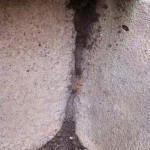

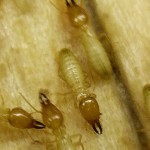
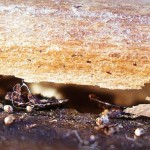

 .
.